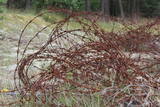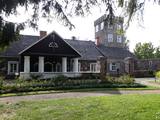| Nr | Nosaukums | Apraksts |
|---|---|---|
|
Saimniecība atrodas gleznainajā Karulas Nacionālajā parkā (Karula Rahvuspark). Šeit var gan paēst, gan pārnakšņot. Ēdiens tiek gatavots pārsvarā no vietējām izejvielām saimniecības virtuvē. Saimniecībā audzē arī gaļas buļļus. |
||
|
Autentiskā Zypliu muižas vidē izveidots restorāns. Kulinārais mantojums - Lietuvas muižniecības ēdieni. Ēdināšana, degustācija, izglītības programmas. |
||
|
Raķešu bāze pretgaisa aizsardzībai izvietota plašā teritorijā dienvidos no Pāvilostas. Pamesta un degradēta dabas teritorija, kur izvietotas brīdinājuma zīmes "Bīstami, apdraud dzīvību".
|
||
|
Seklais un aizaugošais (aizaugums ap 40 %) Liepājas ezers ir viens no nozīmīgākajiem Baltijas jūras piekrastes ligzdojošo un migrējošo putnu (atpūtas, barošanās vieta) ezeriem, kurā konstatētas > 100 putnu sugas. Tas ir arī ne mazāk nozīmīga daudzu iesāļiem biotopiem raksturīgu augu sugu dzīves vieta. Liepājas ezera ziemeļaustrumu krastā – Vītiņu pļavās palieņu pļavu apsaimniekošanas nolūkos ir izlaisti dzīvei savvaļā pielāgotie mājlopi, izveidots skatu tornis, kas pieejams iepriekš piesakoties gida pavadībā. Interesantus skatu punktus un ainavas, kā arī ceļojuma iespaidus var gūt, izstaigājot vai ar velosipēdu izbraukājot (ekstrēmi, sevišķi vasarā!) dambju sistēmu, kas atrodas ezera dienvidrietumu daļā. Ezera apkārtnē atrodas unikālās Liepājas fortifikācijas sistēmas atliekas. |
||
|
Ziemciešu audzētava „Puķu lauki” ir ģimenes uzņēmums, kurā audzē un piedāvā dekoratīvos stādus. Saimniecība ir specializējusies konkrētu augu grupu audzēšanā. Tās laukos bagātīgi zeļ ziemcietes, graudzāles (zāļveida ziemcietes) un dažādas cirpto bukšu formas. Turklāt, šejienes augu šķirnes ir pielāgotas mūsu klimatiskajiem apstākļiem. Apmeklētāji var izstaigāt skaisti iekopto un ainavisko paraugdārzu, kā arī iegādāties stādus plastmasas konteineros visas sezonas garumā. |
||
|
Kalakuningad piedāvā kūpinātas zivis tieši no krāsns, savukārt sezonas laikā svaigas zivis, kā arī marinētas zivis dažādās mērcēs. Produktus var iegādāties Pärnu tirgū veikalā Kalakuningad, kā arī tieši pagatavošanas vietā Lindi ciematā Pärnumaa. |
||
|
Atrodas galvenās Kuldīgas gājēju ielas malā. Sadarbojas ar vietējiem zemniekiem un piedavā Kurzemes novadam raksturīgus ēdienus, kā arī ēdienus no dažādu pasaules valstu receptēm. |
||
|
Parks veidots g.k. daudzveidīgā kultūrvēsturisko objektu klāsta aizsardzībai (Traķu ezerpils, Seno Traķu klosteris, Užutraķu pils, Bražoles pilskalns, karaīmu mantojums u.c.).
|
||
|
Atrodas Lielvārdes parkā pie Rumbiņas ietekas Daugavā. Līdzīgi kā citur, arī šeit 13. gs. pirmajā pusē bīskapa pili cēla nodedzinātās lībiešu koka pils vietā. Mūra pili nopostīja Livonijas kara laikā - 1577. g. Tikai 1987. g. notika drupu konservācija. Lielvārdes parka veidošanu uzsāka 19. gs. beigās Lielvārdes muižas barona Artura fon Vulfa vadībā. Sagaidot eposa „Lāčplēsis” simtgadi tajā izvietoja sešpadsmit no ozolkoka veidotas skulptūras (t.s. Skulptūru dārzs) (autori V. Ansavs, P. Mellis, Ē. Delpers, A. Dauvarte). Aiz pilsdrupām Daugavas krastā ir stāva krauja ar dolomīta iežuatsegumu. Līdz HES ūdenskrātuvei var nokļūt pa kāpnēm. Lielvārdes muižas pils līdz mūsdienām nav saglabājusies. |
||
|
Teritorijas apskates nolūkos ir izveidota un labiekārtota dabas izziņas taka. Dabas liegums atrodas Abavas senlejas dabas parka teritorijā. Taka iepazīstina ar vienīgo krūmu čužas savvaļas augšanas vietu Latvijā. |
||
|
No Ērgļu (Ērģeļu) klinšu skatu laukuma paveras iespaidīgs skats un Latvijas monolītākā smilšakmens atseguma (līdz 22 m augstas) augstāko vietu un Gaujas senleju. Neejiet tuvu klinšu malai!
|
||
|
Naissāre ir viena no Igaunijas mazajām salām, kas periodā no II Pasaules kara beigām līdz 1993. gadam atradās Padomju armijas pārziņā. Savulaik - slepens padomju militārais objekts. Interešu objekti uz salas ir pastaigu takas, sugām bagātā daba, šaursliežu dzelzceļš, cara laika lielgabalu baterijas un jau minētās armijas jūras mīnu rūpnīca. No Tallinas uz Naissāri kursē kuģītis “Monica”. |
||
|
Mājas plombīrs Gogelmogels top Limbažu novada Skultes pagasta Stienes ciema "Ceplīšos". Plombīrs top pēc klasiskas receptes no tīrām, dabiskām izejvielām, neizmantojot e-vielas. Receptē lietotās olas (olu dzeltenumi) nāk no šīs pašas saimniecības kūts, kurā tiek turētas 250-300 dējējvistas. Plombīram ir vairākas šķirnes - klasiskais (vaniļa), strattiacella (ar rūgtās šokolādes skaidiņām), ar smiltsērkšķiem (no pašu lauka) un ar ziedputekšņiem. Iespējams iegādāties arī olas un pašu gatavotu majonēzi. Mājās pieņem gan ekskursijas, gan pircējus. Ekskursantiem piedāvā iepazīties, kā tiek audzētas vistas, kas dod garšīgas olas komplektā ar saldējuma degustāciju un stāstījumu par saldējuma vēsturi. Produkciju iespējams iegādātoes Skultes un Kalnciema kvartāla tirgos, veikalos iDille u.c. |
||
|
Krogs „Sidrabiņi” atrodas Rīgas – Tallinas ceļa malā, netālu no Jelgavkrastiem. Tas iekārtots, atjaunojot vēsturisku koka ēku. Blakus krodziņam izveidots gaļas pārstrādes cehs, kurā top pašu kūpināti gaļas izstrādājumi. Viesiem galdā tiek celti tādi gardi ēdieni kā bukstiņu putra ar čurkstinātu pašu kūpinātu cūkas krūtiņu, pašmāju pelēkie zirņi, putraimdesa ar ceptu speķi un āboliem, pašu kūpināts, sutināts cūkas stilbs ar sinepēm, mārrutkiem un tepat uz vietas skābētiem, štovētiem kāpostiem. |
||
|
Vairāk nekā pusgadsimtu vecais dabas parks ir populārs tūrisma objekts un latviešu rakstnieces Annas Brigaderes (1861. - 1933) pasaku lugu varoņu apskates vieta. Sava mūža pēdējo desmitgadi (no 1922. līdz 1933. g.) rakstniece strādā un atpūšas Tērvetes „Sprīdīšos” (ēka uzbūvēta 1840 g.). Laikā no maija līdz oktobrim mazos apmeklētājus sagaida arī „dzīvie” pasaku tēli. Pazīstamas ir Tērvetes vecās priedes, kuru vecums sasniedzis trīs gadsimtus. Parka teritoriju caurvij takas, tādēļ šī ir piemērota vieta dažāda garuma un grūtības pastaigām. Nesen izveidots mūsdienīgs apmeklētāju centrs. |
||
|
Produktu izgatavošana no ārstniecības augiem - tējas, sīrupi, augu pulveri, ziedes. Pakalpojumu piedāvājums - ekskursijas, radošās darbnīcas, meistarklases, pirts. |
||
|
Saimniecības drava atrodas netālu no Isnaudas pagasta Bobišiem, dabiskā vietā, kur dabiskā vidē nav lauksaimniecībā izmantojamo zemju un citu objektu. Bišu iegūtā produkcija tiek pārstrādāta Zilupē, Sila ielā 4, kur saimnieki uzņem ekskursijas un var iegādāties saražotos labumus. Saimniecība ir bioloģiski sertificēta. Iegūst liepu un dažādziedu medu. |
||
|
Burbišķes muižā 1991. gadā ierīkots Daugivenes kultūras vēstures muzejs – liegums aizņem 28 ha platību. Centrālajā parka daļā ir 3 ha dīķis ar 15 salām, 11 tiltiem un tiltiņiem. Kopš 2000. gada te tiek organizēti tulpju ziedēšanas svētki, kuru laikā tiek eksponētas ap 300 šķirņu tulpes. |
||
|
Meklējama uz dienvidiem no Ludzas pilskalna, vietā, kur paveras skaists skats un Lielo Ludzas ezeru. Pirmā katoļu baznīca Ludzas Baznīckalnā bija celta 1687. g., taču tā nodega ugunsgrēkā. 1738. g. uzcēla jaunu koka baznīcu baroka stilā, ko krāšņā interjera dēļ dēvēja par Latvijas skaistāko koka dievnamu. Tā nodega 1938. g. lielajā pilsētas ugunsgrēkā. Tagad redzamās celtniecību uzsāka 1939. g., bet pilnībā pabeidza un atjaunoja tikai deviņdesmito gadu sākumā. |
||
|
Otra Latvijas vecākā (1849. – 1850. g.), visaugstāk (82 m v.j.l., t.sk. 32 m augsts tornis) esošā un iekšzemē vistālāk (5 km no jūras) celtā bāka. Tās bākuguni izslēdza 1999. g. un mūsdienās bāka kalpo kā lielisks skatu tornis un izstāžu zāle. Skaidrā laikā no bākas labi redzams Irbes šaurums un Serves rags (Sāmsalā) ar Serves bāku. Pie bākas atrodas Šlīteres dabas taka, ko var iziet tikai nacionālā parka gida pavadībā. Taka atrodas dabas rezervātā, kur 1923. g. dibināja Šlīteres dabas pieminekli. Apmeklētāji varēs iepazīt Šlīteres Zilos kalnus - Baltijas ledus ezera senkrasta stāvo krauju, nogāžu un platlapju mežus, avoksnāju, kaļķainu zāļu purvu, kā arī senas meliorācijas grāvju atliekas un satrupējušos egļu stumbrus, kurus sagāza vējš 1969. gada orkāna laikā. Takas garums 1,2 km. Dabas izglītības centrs “Slītere” ietver dabas taku, bāku, ēku ar ekspozīciju “Dzīvība kokā”, kā arī pagalmu, kur notiek dabas izglītības nodarbības. |
||























